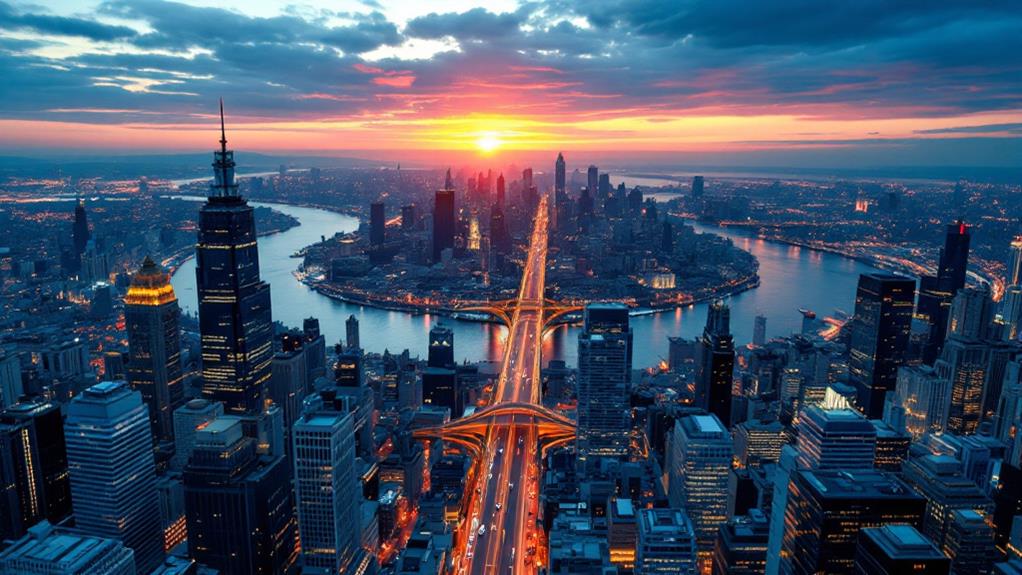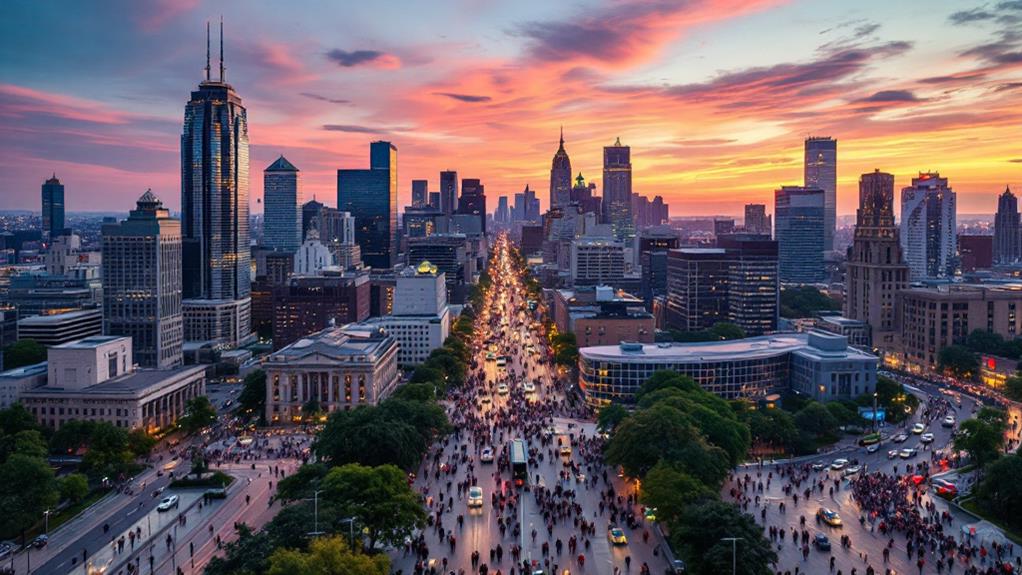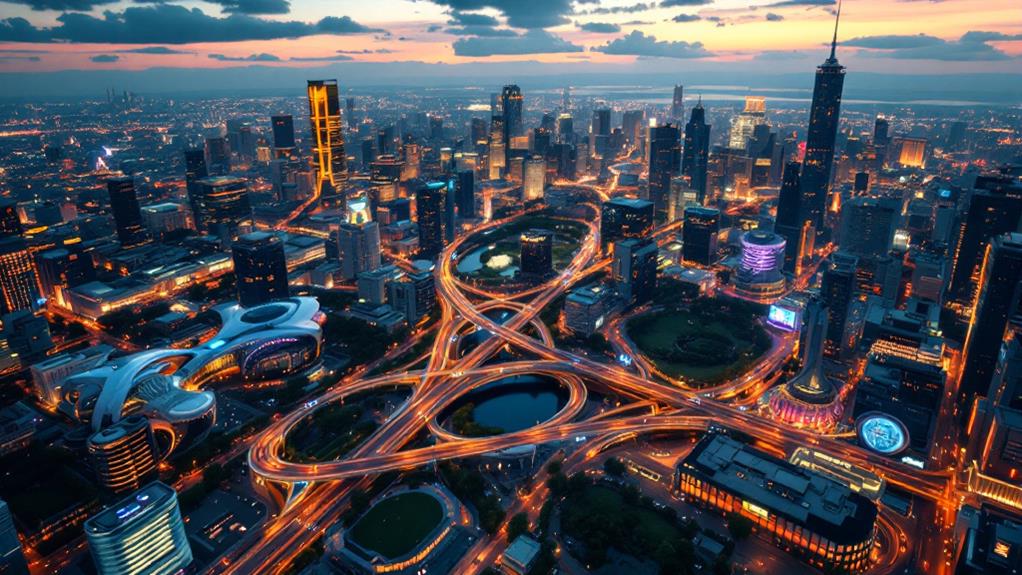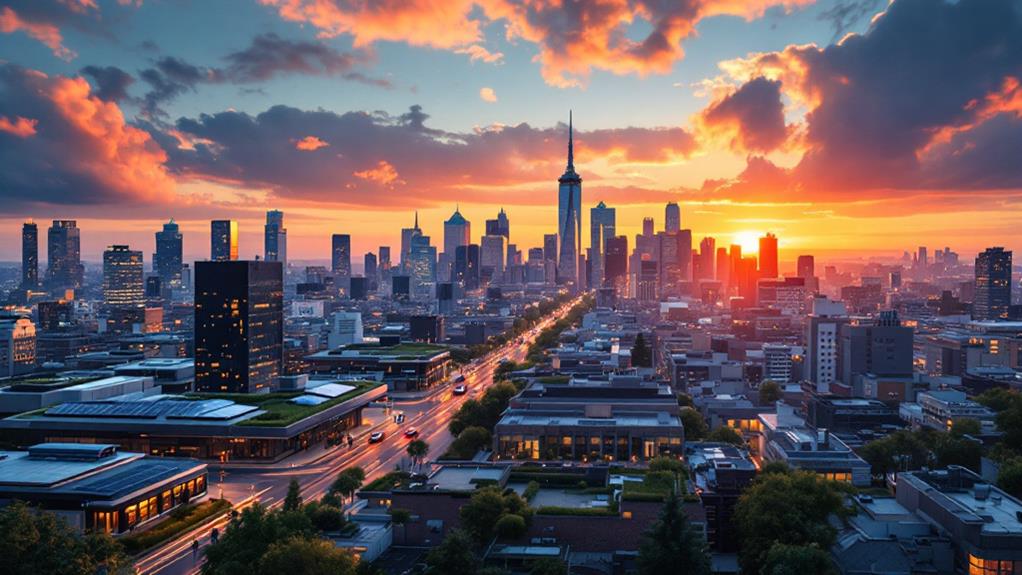A Guide to the Largest Urban Areas in North America

When exploring North America's largest urban areas, you're stepping into vibrant centers like Mexico City and New York City, with populations of 9.2 and 8.8 million, respectively. These lively metropolises highlight the density and diverse cultures within their areas. Also notable are Los Angeles and Toronto, key economic hubs with distinct personalities. Urban agglomerations distinctly blend city and suburb, shaping demographic and economic landscapes. Urbanization continues to grow, stressing the importance of sustainable development to tackle environmental challenges. Curious about statistics like density or economic impact? Let's look deeper into how these cities shape our future.
Understanding Urban Agglomerations
Urban agglomerations, encompassing densely populated cities and their surrounding suburbs, are crucial to understanding the dynamics of population density and economic activity. You'll notice how these urban and metropolitan areas are continuously evolving, reflecting significant population growth. In the U.S., urban agglomerations like New York City have seen substantial increases, with its population reaching 8.8 million, making it one of the largest in North America. This growth highlights the trend toward urbanization, with a striking 83% of the U.S. population now living in urban areas.
The definition of metropolitan areas has shifted since 1910, focusing more on integrating suburbs with urban centers. This change is primarily based on commuting patterns and population density, illustrating how the boundaries of what you consider a city have expanded over time. It's fascinating to see how cities like Mexico City, which tops the list in North America with 9.2 million people and a density of 6,160 people per square kilometer, exemplify these trends. By understanding these dynamics, you can better grasp the factors driving economic activity and demographic shifts within these burgeoning urban landscapes.
Major Cities in North America
North America's major cities are lively hubs of culture, economy, and innovation, each with its distinct characteristics. When you investigate these urban areas, you'll find Mexico City leading the pack as the largest, boasting a population of approximately 9.2 million. It thrives with a high density of 6,160 people per square kilometer. Not far behind, New York City stands as a significant global cultural and economic center. Its population of 8.8 million is packed into a density of 7,252 people per square kilometer, making the city a thriving metropolis.
Los Angeles, known for its entertainment industry, houses 3.9 million residents. Sprawling over 1,302.2 square kilometers, it maintains a density of 2,994 people per square kilometer. As you head north, Toronto, the largest city in Canada, greets you with its multicultural vibe. It has a population of 2.8 million and a density of 4,434 people per square kilometer. Finally, Chicago, the third largest city in the U.S., captivates with its architectural marvels and lively arts scene. Its population of 2.7 million lives within a density of 4,529 people per square kilometer, rounding out these urban giants.
Population Insights and Trends

Understanding population insights and trends in North America reveals a dynamic landscape of urban growth and concentration. The urban population is expanding rapidly, and cities are becoming hubs of human activity. In Mexico City, the largest urban agglomeration on the continent, around 9.2 million people contribute to its lively atmosphere. New York City closely follows, with a population of 8.8 million, highlighting its importance as a metropolitan statistical area.
In the U.S., urbanization has surged with 83% of the population now residing in urban regions, a substantial rise from 64% in 1950. This trend continues to reshape growth in America with predictions indicating that by 2050, 89% of the population will be urban dwellers. The expansion of urban land, which grew by 14% from 2000 to 2020, is expected to double by 2060.
- 83% of the U.S. population lives in urban areas.
- Mexico City leads with 9.2 million residents.
- Top 30 U.S. metropolitan areas house over 2 million people.
- Urban land area projected to double by 2060.
These trends illustrate a shifting demographic landscape, emphasizing the importance of urban centers in North America.
Economic Impact of Urban Areas
As urban areas in North America grow and evolve, they play an essential role in shaping the economic landscape of the continent. Major urban agglomerations like New York City and Los Angeles are not just cultural hubs; they're economic powerhouses. These cities contribute markedly to national GDP, with metropolitan areas making up a whopping 91.1% of the U.S. economy back in 2018. You can see how urban planning and strategic development in the largest U.S. cities foster economic growth.
Jobs are abundant in these regions, spanning diverse sectors that attract both domestic and international investments. This influx fuels innovation and keeps the economic engine humming. For instance, a $1 billion investment in public transit infrastructure can lead to $5 billion in GDP growth and create nearly 50,000 new jobs. It's clear that transportation improvements pay off.
However, it's not all rosy. Urban areas often face income disparities, with the top 5% earning 11.6 times more than the bottom 20%. Despite a robust labor market, with an unemployment rate of just 3.9% in March 2024, economic inequality remains a pressing challenge in these vibrant metropolises.
Urbanization and Future Prospects

Urbanization in North America keeps ramping up, fundamentally altering the landscape and lifestyle of its inhabitants. A whopping 83% of the U.S. population now lives in urban areas, a sharp rise from 64% in 1950. This shift isn't just a passing trend; by 2050, an estimated 89% of Americans will reside in urban zones. For the largest metropolitan areas, this means more than just growing numbers—it's about adapting to the future with smart growth strategies.
- Urban land in the U.S. increased by 14% from 2000 to 2020.
- Projections suggest this figure will double by 2060.
- Urban areas contribute to 70% of global emissions.
- Sustainable development is vital to mitigate environmental impacts.
The implications of urbanization extend beyond just numbers. Increasing urban populations lead to higher demands on infrastructure and resources, which can be challenging for even the largest metropolitan areas. Smart growth becomes necessary, focusing on sustainable development to curb adverse environmental impacts. Urban centers must innovate and implement eco-friendly policies to tackle these challenges head-on, ensuring that they can support future generations while maintaining a livable environment. The path forward requires a keen balance between growth and sustainability.
Metropolitan Definitions and Criteria
Metropolitan areas in the U.S. have evolved considerably since the 1910 census initially introduced their definition. Back then, a metropolitan area needed a minimum population of 100,000. But by 1950, this was revised to 50,000 to reflect suburban growth. This change acknowledged how suburban areas increasingly integrated with core cities, forming larger urban landscapes.
In the United States, understanding metropolitan areas involves examining Combined Metropolitan Statistical Areas (CMSAs). These are defined as urban regions that include a city with over 50,000 residents, its suburbs, and a combined population of at least 100,000–75,000 in New England. The Census Bureau plays an essential role here, as they assess the integration of suburbs with core cities by analyzing commuting patterns and population density. This assessment highlights the strong interdependence between urban and suburban areas.
Addressing Environmental Challenges

Having examined the intricacies of metropolitan areas, it is fundamental to address the pressing environmental challenges they face. Urban areas contribute considerably to global greenhouse gas emissions, nearly 70%, underscoring the need for sustainable practices. The urban heat island effect, which raises temperatures by 1-7°F, exacerbates energy use and public health concerns. To tackle these issues, consider the following strategies:
- Urban Greening: Increase tree cover to improve air quality and help regulate temperatures.
- Stormwater Management: Implement effective systems to reduce runoff and protect water quality.
- Emissions Reduction: Adopt policies aimed at lowering greenhouse gas emissions from transportation and industry.
- Integrated Environmental Management: Protect stream ecosystems from urban development impacts.
Urban greening plays a central role in enhancing quality of life and addressing climate challenges. Trees and green spaces reduce air pollution and counteract temperature rise. Concurrently, efficient stormwater management is imperative to prevent water quality deterioration. By adopting these strategies, you'll help mitigate the adverse effects of urbanization. It is a collective effort that requires commitment to sustainable development and creative approaches. As urban areas continue to grow, taking concrete steps to address these environmental challenges is crucial for a healthier future.



